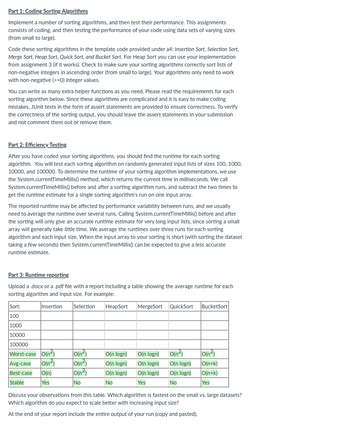Question
Please answer all the parts thanks

Transcribed Image Text:Part 1: Coding Sorting Algorithms
Implement a number of sorting algorithms, and then test their performance. This assignments
consists of coding, and then testing the performance of your code using data sets of varying sizes
(from small to large).
Code these sorting algorithms in the template code provided under a4: Insertion Sort, Selection Sort,
Merge Sort, Heap Sort, Quick Sort, and Bucket Sort. For Heap Sort you can use your implementation
from assignment 3 (if it works). Check to make sure your sorting algorithms correctly sort lists of
non-negative integers in ascending order (from small to large). Your algorithms only need to work
with non-negative (>=0) integer values.
You can write as many extra helper functions as you need. Please read the requirements for each
sorting algorithm below. Since these algorithms are complicated and it is easy to make coding
mistakes, JUnit tests in the form of assert statements are provided to ensure correctness. To verify
the correctness of the sorting output, you should leave the assert statements in your submission
and not comment them out or remove them.
Part 2: Efficiency Testing
After you have coded your sorting algorithms, you should find the runtime for each sorting
algorithm. You will test each sorting algorithm on randomly generated input lists of sizes 100, 1000,
10000, and 100000. To determine the runtime of your sorting algorithm implementations, we use
the System.currentTimeMillis() method, which returns the current time in milliseconds. We call
System.currentTimeMillis() before and after a sorting algorithm runs, and subtract the two times to
get the runtime estimate for a single sorting algorithm's run on one input array.
The reported runtime may be affected by performance variability between runs, and we usually
need to average the runtime over several runs. Calling System.currentTimeMillis() before and after
the sorting will only give an accurate runtime estimate for very long input lists, since sorting a small
array will generally take little time. We average the runtimes over three runs for each sorting
algorithm and each input size. When the input array to your sorting is short (with sorting the dataset
taking a few seconds) then System.currentTimeMillis() can be expected to give a less accurate
runtime estimate.
Part 3: Runtime reporting
Upload a .docx or a .pdf file with a report including a table showing the average runtime for each
sorting algorithm and input size. For example:
Sort:
Insertion
Selection
HeapSort MergeSort QuickSort
BucketSort
100
1000
10000
100000
Worst-case O(n)
O(n²)
O(n logn)
O(n logn)
O(n²)
O(n²)
Avg-case
O(n²)
O(n²)
O(n logn)
O(n logn)
O(n logn)
Best-case O(n)
O(n²)
O(n logn)
O(n logn)
O(n logn)
O(n+k)
O(n+k)
Stable
Yes
No
No
Yes
No
Yes
Discuss your observations from this table. Which algorithm is fastest on the small vs. large datasets?
Which algorithm do you expect to scale better with increasing input size?
At the end of your report include the entire output of your run (copy and pasted).
SAVE
AI-Generated Solution
info
AI-generated content may present inaccurate or offensive content that does not represent bartleby’s views.
Unlock instant AI solutions
Tap the button
to generate a solution
to generate a solution
Click the button to generate
a solution
a solution
Knowledge Booster
Similar questions
- List the location name and location ID where the location ID is 1400, 1500, or 1800. Use INoperator. Do not use OR operator.arrow_forwardPlease___Outline the step-by-step process of resolving a domain name, including recursive and iterative queries.?arrow_forwardPlease provide two customer-writer arguments. Please answer my question in the specified section. according to computer experts.arrow_forward
- SQL BITS List client number, balance, consultant number, and consultant last name of every client whose balance is greater than that of client number '405.'arrow_forwardSome of the inquiries that need a response are as follows:.arrow_forwardWhich type of queuing presupposes that clients be serviced in what order?arrow_forward
- Normalize the following table to the 3rd Normal form: Student Student Phone Course Term Grade Instructor Instructor Phone Lauren Fernell 555-7771 MIS 350 F12 A Hess 555-2222 Lauren Fernell 555-7771 MIS 372 F12 B Sarker 555-2224 Lauren Fernell 555-7771 MIS 426 F12 A Fuller 555-2227 Lauren Fernell 555-7771 MIS 375 F12 B+ Wells 555-2228 Brigit Schnieder 555-2215 MIS 350 F12 A Hess 555-2222 Brigit Schnieder 555-2215 MIS 375 F12 B+ Wells 555-2228 Brigit Schnieder 555-2215 MIS 372 F12 A Sarker 555-2224 Brigit Schnieder 555-2215 MIS 374 F12 B Clay 555-2221 Jackie Judson 555-1245 MIS 350 F12 A Hess 555-2222 Jackie Judson 555-1245 MIS 372 F12 B+ Sarker 555-2224 How many tables did you create after normalizing the table? List each of…arrow_forwardWhat is a split-by clause and when should it be used?arrow_forwardWhich Oracle 12c rights are available? Classify each.arrow_forward
arrow_back_ios
arrow_forward_ios